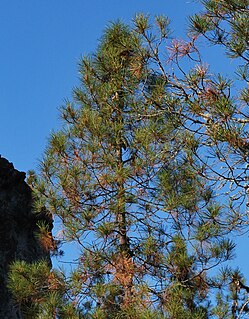
Pinus serotina, the pond pine, marsh pine or pocosin pine, is a pine tree found along the Southeastern portion of the Atlantic coastal plain of the United States, from southern New Jersey south to Florida and west to southern Alabama. This pine often has a crooked growth pattern and an irregular top and grows up to 21 metres (69 ft) high, rarely to 29 metres (95 ft).

Jack pine is an eastern North American pine. Its native range in Canada is east of the Rocky Mountains from the Mackenzie River in the Northwest Territories to Cape Breton Island in Nova Scotia, and the north-central and northeast of the United States from Minnesota to Maine, with the southernmost part of the range just into northwest Indiana and northwest Pennsylvania. It is also known as grey pine and scrub pine.

Pinus glabra, the spruce pine, is a tree found on the coastal plains of the southern United States, from southern South Carolina south to northern Florida and west to southern Louisiana. This pine is a straight-growing, medium-sized species, attaining heights of 20–40 m.

The knobcone pine, Pinus attenuata, is a tree that grows in mild climates on poor soils. It ranges from the mountains of southern Oregon to Baja California with the greatest concentration in northern California and the Oregon-California border.

Pinus muricata, the bishop pine, is a pine with a very restricted range: mostly in California, including several offshore Channel Islands, and a few locations in Baja California, Mexico. It is always on or near the coast.

Pinus arizonica, commonly known as the Arizona pine, is a medium-sized pine in northern Mexico, southeast Arizona, southwest New Mexico, and western Texas in the United States. It is a tree growing to 25–35 m tall, with a trunk diameter of up 1.2 m. The needles are in bundles of 3, 4, or 5, with 5-needle fascicles being the most prevalent. This variability may be a sign of hybridization with the closely related ponderosa pine. The cones are single, paired, or in whorls of three, and 5–11 cm long.

Pinus engelmannii, commonly known as the Apache pine, is a tree of Northern Mexico, in the Sierra Madre Occidental with its range extending a short distance into the United States in southwestern New Mexico and southeastern Arizona. This pine is a medium-sized species with a height of 20–30 m (66–98 ft) and a trunk diameter of 35–80 cm (14–31 in).

Pinus sibirica, or Siberian pine, in the family Pinaceae is a species of pine tree that occurs in Siberia from 58°E in the Ural Mountains east to 126°E in the Stanovoy Range in southern Sakha Republic, and from Igarka at 68°N in the lower Yenisei valley, south to 45°N in central Mongolia.

Pinus merkusii, the Merkus pine or Sumatran pine, is a pine native to the Malesia region of southeast Asia, mainly in Indonesia in the mountains of northern Sumatra, and with two outlying populations in central Sumatra on Mount Kerinci and Mount Talang, and in the Philippines on Mindoro and in the Zambales Mountains on western Luzon.

Pinus thunbergii, also called black pine, Japanese black pine, and Japanese pine, is a pine tree native to coastal areas of Japan and South Korea.

Pinus armandii, the Armand pine or Chinese white pine, is a species of pine native to China, occurring from southern Shanxi west to southern Gansu and south to Yunnan, with outlying populations in Anhui. It grows at altitudes of 2200–3000 m in Taiwan, and it also extends a short distance into northern Burma. In Chinese it is known as "Mount Hua pine" (华山松).

Pinus occidentalis, also known as the Hispaniolan pine or Hispaniola pine, is a pine tree endemic to the island of Hispaniola.

Pinus durangensis, the Durango pine, is a pine tree species endemic to the Sierra Madre Occidental mountain range of north-western Mexico.

Pinus cubensis, or Cuban pine, is a pine endemic to the eastern highlands of the island of Cuba, inhabiting both Sierra Nipe-Cristal and Sierra Maestra.

The Caribbean pine is a hard pine species native to Central America and the northern West Indies. It belongs to subsection Australes in subgenus Pinus. It inhabits tropical and subtropical coniferous forests such as Bahamian pineyards, in both lowland savannas and montane forests.

Pinus massoniana is a species of pine, native to Taiwan, and a wide area of central and southern China, including Hong Kong, and northern Vietnam, growing at low to moderate altitudes, mostly below 1,500 m but rarely up to 2,000 m altitude.

Pinus oocarpa is a species of pine tree native to Mexico and Central America. It is the national tree of Honduras, where it is known as ocote. Common names include ocote chino, pino amarillo, pino avellano, Mexican yellow pine, egg-cone pine and hazelnut pine. It appears that it was the progenitor (original) species that served as the ancestor for some of the other pines of Mexico.
Actinodaphne lawsonii is a species of plant in the family Lauraceae. It is endemic to India. It is threatened by habitat loss.
Glyptopetalum lawsonii is a species of plant in the family Celastraceae. It is endemic to Tamil Nadu in India.
Memecylon lawsonii is a species of plant in the family Melastomataceae. It is endemic to India.



















